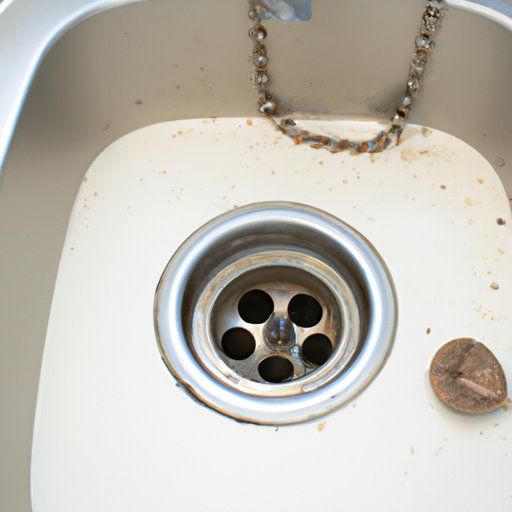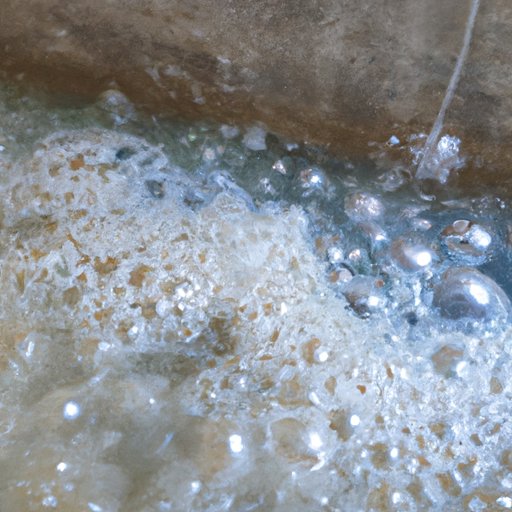
I. Introduction
Dealing with a clogged sink drain is a common problem that almost everyone encounters at some point. A clogged sink drain can cause a lot of frustration and inconvenience, but it doesn’t have to be a major problem. This article provides a detailed guide on how to clean sink drain using different methods. Whether you prefer natural or traditional methods, chemical agents, or tools such as a plunger or plumbing snake, this guide has you covered.
II. The Traditional Method: Using Baking Soda and Vinegar
The baking soda and vinegar method is an age-old, reliable, and budget-friendly way to clean sink drain. To unclog a sink drain using this method:
- Pour a pot of boiling water down the sink drain to loosen up the clog.
- Pour one cup of baking soda down the drain and wait for a few minutes.
- Pour one cup of vinegar down the drain and cover it for about 10 minutes. The chemical reaction of the baking soda and vinegar will break down the clog.
- Pour another pot of boiling water down the sink to wash away any remaining residue.
The baking soda and vinegar method is effective, environmentally friendly, and requires household items easily found in the kitchen. The only disadvantage of this method is that it may not be effective for heavy blockages.
III. The Natural Way: Using Lemon and Salt
If you prefer natural alternatives to cleaning a sink drain, try using lemon and salt. Here are the instructions:
- Pour a few tablespoons of salt into the sink drain.
- Cut a lemon into quarters and squeeze the juice into the sink drain. Also, drop the lemon pieces into the drain.
- Pour hot water down the sink drain to clear away the clog.
Lemon and salt are an excellent natural alternative to clean sink drain, remove bad smells, and are environmentally friendly. However, like the baking soda and vinegar method, they may not be effective for heavily clogged sinks.

IV. The Chemical Solution: Using Drain Cleaning Agents
Drain cleaning agents are a fast and easy way to clean sink drain, and they work well for heavy blockages. Commercial and household drain cleaning agents available in stores work similarly. Here’s what to do:
- Choose a drain cleaning agent and follow the instructions provided on the package.
- Let the cleaning agent sit for the recommended time.
- Rinse the sink drain with hot water to wash away the clog and any residue.
Different drain cleaning agents may contain different chemicals, and care should be taken when handling them. Always wear gloves and protective gear, read the instructions carefully, and keep the chemicals out of reach of children and pets.
V. The Power of Boiling Water: Simply Pouring Boiling Water Down the Drain
Boiling water is a useful, inexpensive, and effective technique to clear minor sink clogs. Here’s what to do:
- Boil a pot of water on the stove.
- Pour the boiling water directly into the sink drain, slowly and carefully.
- Repeat the process if necessary until the clog clears away.
Avoid using boiling water on porcelain sinks or PVC pipes, and also, be careful when pouring the water down the drain as the heat can damage your skin.
VI. The Power of a Plunger: Plunging the Sink Drain
A plunger is an excellent tool to clear blockages from a sink drain. Here are the instructions:
- Run hot water into the sink and plug the overflow hole.
- Place the plunger firmly over the sink drain and push down and pull up several times until the clog clears away.
- Rinse the sink drain with hot water to clear away any remaining debris.
Ensure that there is enough water in the sink and identify where the water is leaking before placing the plunger. Use a cup plunger instead of a flange plunger if you can’t get a reliable seal over the sink drain.
VII. The Mechanical Approach: Using a Plumbing Snake or Auger
If the sink drain is heavily clogged, a plumbing snake or auger is the best mechanical approach to clean it. Follow these steps:
- Insert the snake into the sink drain until you reach the clog.
- Turn the snake handle clockwise as you push it into the sink drain, and the snake head should drill through the blockage.
The plumbing snake or auger is an effective tool to clear toilet clogs, but it’s challenging to use and may cause permanent damage to the pipes if not used correctly.
VIII. Preventative Measures: Tips for Maintaining a Clean Sink Drain to Avoid Clogging
The best way to prevent clogs from forming in your sink drain is to practice good habits. Here are some tips:
- Pour hot water down the sink drain regularly.
- Avoid pouring fat, oil, and grease down the drain.
- Scrape leftover food waste into the trash bin instead of letting it go down the sink drain.
- Use sink strainers to catch small debris to prevent it from going down the drain.
- Clean the sink drain regularly with all-natural cleaners to keep it free of debris.
Taking preventative measures is key, and simple steps like using a strainer and cleaning the drain regularly can prevent a backlog of future sink clogs.
IX. Conclusion
Cleaning sink drain effectively doesn’t have a one-size-fits-all method. This article has highlighted several cleaning methods, and whichever you choose depends on the severity of the clog and your preferences. Start with the most straightforward and least invasive method and work your way up until the clog clears away. For tough clogs, you may have to use several methods or hire a professional plumber. It’s essential to take preventative measures to maintain the cleanliness of your sink drain regularly. Don’t wait until there’s a clog to start keeping your sink drain clean and prevent inconveniences.




